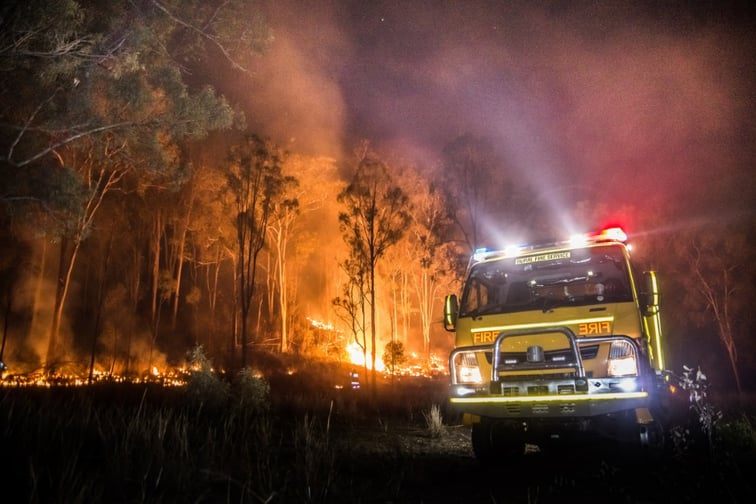

It seems like Canada is still recovering from the catastrophic wildfires that ravaged through the country last year — however, due to current weather conditions, provinces and municipalities are preparing for an earlier start to this destructive season.
“For all intents and purposes, wildfire season has already started, with drought being the number one reason for this,” said Glenn McGillivray, managing director for the Institute for Catastrophic Loss Reduction (ICLR).
“Snowpack is also very low this year. We’ve had lots of really mild weather across the country, not a whole lot of precipitation, which is crucial in preventing the spread of wildfires.”
While McGillivray notes that there is traditionally a two-week period in the spring that can bring about enough precipitation to thwart any destructive environmental events, there is the expectation that this year’s wildfires will be just as bad, or worse, than last year’s.
There is also the presence of zombie fires to be mindful of.
“Zombie fires happen when a wildfire goes underground, which is common,” McGillivray said.
“But it’s not common to have 120 of them at this time of year. They could resurface and continue their path of destruction.”
He noted how British Columbia has a 12-month preparedness plan in place for wildfires, while Alberta has moved its wildfire season start date from April 1 to February 1 and is hiring firefighters to help prepare for whatever destruction may come.
In an interview with Insurance Business, McGillivray spoke about what changes and actions need to be implemented to stop widespread destruction. He also debunked a common misconception about wildfires and discussed why a labour shortage could impede urgent fire extinguishing services.
It is key that insurance professionals relay this important message to their insureds: get fuel away from the immediate vicinity of the house.
“This includes flammable vegetation — such as balsam trees — in and around the property, as well as wooden sheds, piles, decks and fences, and propane tanks,” McGillivray said.
“Wood fences were especially a big problem in the Fort McMurray fires of 2016.”
A broker or other insurance professional can recommend alternatives, such as masonry or stucco alternatives.
However, McGillivray admits that educating homeowners can be a tough nut to crack.
“It’s wishful thinking for insurers to think that if they tell someone to do something, that the person will listen,” he said.
“We are seeing community groups across the country, such as a homeowners’ or neighborhood association, being created to help raise awareness for wildfire preparedness and prevention, but we have a long, long way to go.”
In the grander scheme of things, McGillivray also thinks that the government needs to tackle this issue at a provincial and federal level.
“We would like to see Canada as the first country to have a nationwide building code for wildfire risk areas,” he said, “especially since it does not add a whole lot of costs to the price of a home.”
From an insurance perspective, the ICLR has been working with carriers to try and implement build back better initiatives to create more resilient buildings in the aftermath of a loss event.
“On the wildfire side, it’s making sure there’s a class A roof on the property and that homes do not have a vinyl siding but a cement alternative instead,” McGillivray said.
“When Canadian insurers rebuilt Fort McMurray, they put it back with vinyl siding. We’d like to see build back better be implemented in the claims processes of Canadian insurance companies.”
McGillivray is keen on seeing one vital part of wildfire knowledge become more mainstream throughout Canada - and that is how they start.
“Everybody seems to think there’s a wall of fire in the forest that just comes into the community and keeps on going and there’s nothing you can do about it,” he said.
“And that’s totally false, the way it enters community is through embers. The fire starts out in the woods, it starts burning material, the embers then get sucked into the atmosphere and blown far away from the fire. A very intense fire can create its own weather patterns.”
McGillivray compares this to millions of lit cigarette butts falling from the sky.
“Also, these embers never really directly impact a house, instead, they light a nearby bush or woodpile which then travels to the home,” he said.
“If you can prevent those embers from having anything to ignite, that’s the best way you protect a property. Time and time again, forensic investigations show this to be the start of many devastating losses.”
McGillivray recommends brokers direct insureds to FireSmart Canada to get more information about wildfires.
While much can be said of the insurance industry’s talent and recruitment woes, the government is also lacking essential manpower to help extinguish these fires right now.
“In the past, post-secondary students were relied on to help calm or get rid of wildfires,” McGillivray said.
“But what happens now when the wildfire season starts while these individuals are still in school and what do we do in September when they’re back and these wildfires are still raging on?”
This poses a problem, especially for overnight aerial extinguishing efforts — which is a new remedial effort Alberta had to resort to last year — as most staff will not be able to work double shifts to try and keep the flames tamed.
“We’ve got to start thinking about where these people are going to come from,” McGillivray said.
